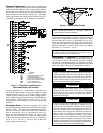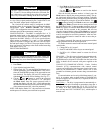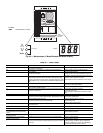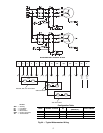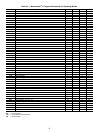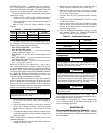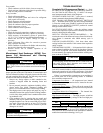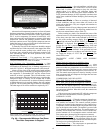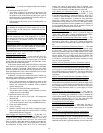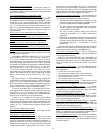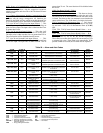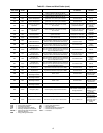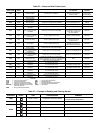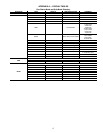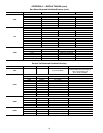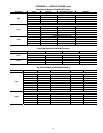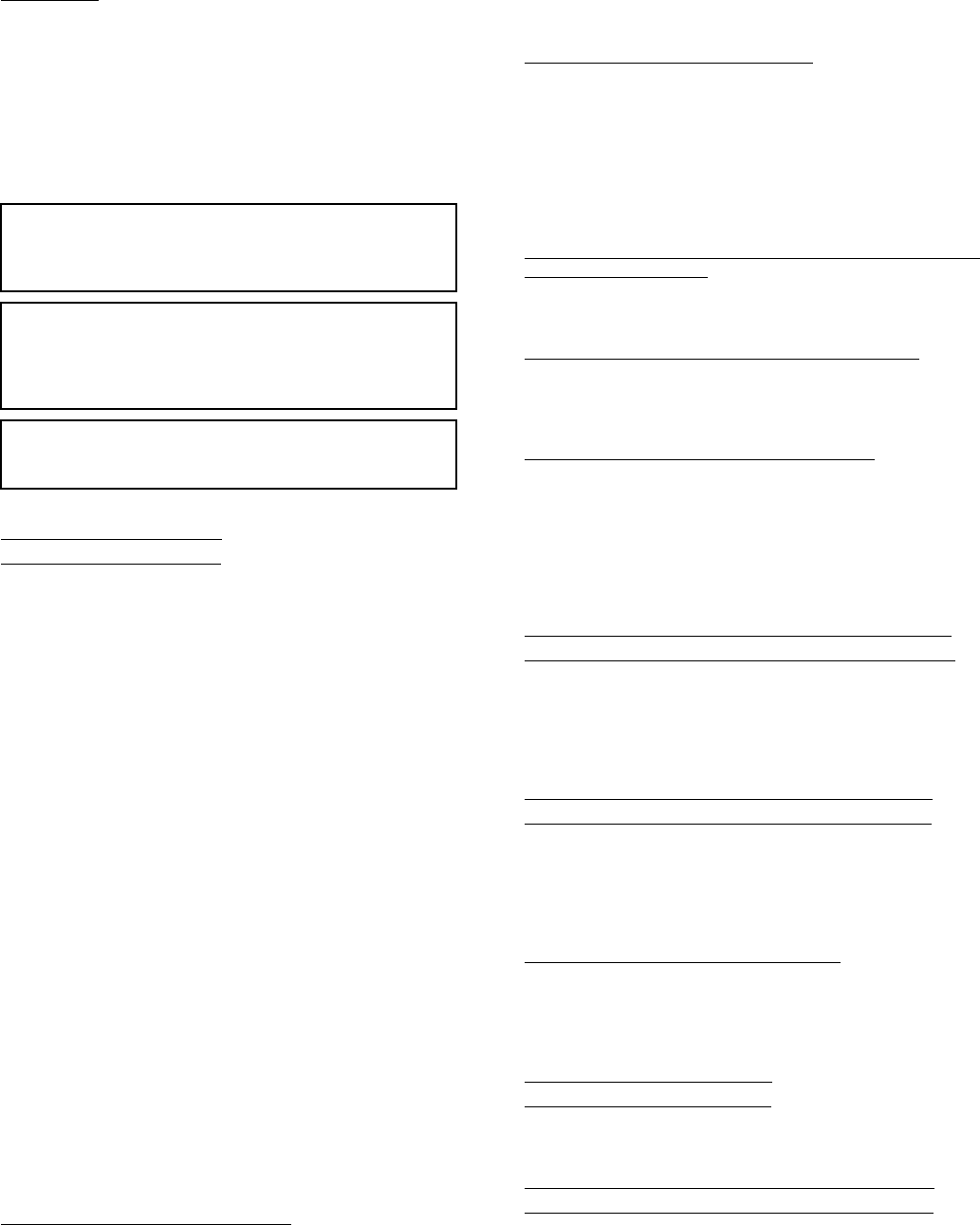
62
Wiring Error
— A wiring error might not allow the compres-
sor to start.
To check out alerts T051-T057:
1. Turn on the compressor in question using Service Test
mode. If the compressor does not start, then most likely
the problem is one of the following: HPS open, open in-
ternal protection, circuit breaker trip, incorrect safety wir-
ing, or incorrect compressor wiring.
2. If the compressor does start, verify it is rotating in the cor-
rect direction.
COMPRESSOR STUCK ON FAILURE ALARMS
Circuit A A051, A052, A053
Circuit B A055, A056, A057 — Alarm codes 051, 052, 053,
055, 056 and 057 are for compressors A1, A2, A3, B1, B2 and
B3. These alarms occur when the current sensor (CS) detects
current when the compressor should be off. When this occurs,
the control turns off the compressor.
If the current sensor board reads ON while the compressor
relay has been commanded OFF for a period of 4 continuous
seconds, an alarm is generated. These alarms are only moni-
tored for a period of 10 seconds after the compressor relay has
been commanded OFF. This is done to facilitate a service tech-
nician forcing a relay to test a compressor.
In addition, if a compressor stuck failure occurs and the cur-
rent sensor board reports the compressor and the request off,
certain diagnostics will take place as follows:
1. If any of the compressors are diagnosed as stuck on and
the current sensor board is on and the request is off, the
control will command the condenser fans to maintain
normal head pressure.
2. The control will shut off all other compressors.
The possible causes include welded contactor or frozen
compressor relay on the MBB.
To check out alarms A051-A057:
1. Place the unit in Service Test mode. All compressors
should be off.
2. Verify that there is not 24-v at the contactor coil. If there
is 24 v at the contactor, check relay on MBB and wiring.
3. Check for welded contactor.
4. Verify CS wiring.
5. Return to Normal mode and observe compressor opera-
tion to verify that compressor current sensor is working
and condenser fans are energized.
A060 (Supply Air Thermistor Failure)
— If the unit is re-
quired to use the supply air thermistor input (C.TYP 1, 3, 5, and
9) and the sensor reading is outside the range of –40 to 245 F
(–40 to 118 C) then the alarm will occur. The cause of the
alarm is usually a faulty thermistor, a shorted or open thermis-
tor caused by a wiring error, or a loose connection. If the sup-
ply temperature is being written to by CCN or a third party
control, the supply-air temperature must be updated every
3 minutes. If it is not updated, then the alarm will be generated.
Failure of this thermistor will shut down the entire unit.
A061 (Return Air Thermistor Failure)
— If the unit is re-
quired to use the return air thermistor input (C.TYP 1, 3, 5, and
9) and the sensor reading is outside the range of –40 to 245 F
(–40 to118 C) then the alarm will occur. The cause of the alarm
is usually a faulty thermistor, a shorted or open thermistor
caused by a wiring error, or a loose connection. If the return
temperature is being written to by CCN or a third party control,
the return-air temperature must be updated every 3 minutes. If
it is not updated, then the alarm will be generated. Failure of
this thermistor will shut down the entire unit.
T068, T69 (Circuit A,B Compressor Return Gas Tempera-
ture Thermistor Failure) — This alert occurs when the com-
pressor return gas temperature sensor is outside the range of
–40 to 245 F (–40 to 118 C). Failure of this thermistor will dis-
able any elements of the control which requires its use.
T073 (Outside Air Temperature Thermistor Failure)
— This
alert occurs when the outside air temperature sensor is outside
the range of –40 to 245 F (–40 to 118 C). Failure of this therm-
istor will disable any elements of the control which requires its
use.
T074 (Space Temperature Thermistor Failure)
— This alert
occurs when the space temperature sensor is outside the range
of –40 to 245 F (–40 to 118 C). Failure of this thermistor will
disable any elements of the control which requires its use. If the
unit is configured for SPT 2 stage or SPT multi-stage operation
and the sensor fails, no cooling mode may be chosen. The
cause of the alert is usually a faulty thermistor in the T55, T56,
or T58 device, a shorted or open thermistor caused by a wiring
error, or a loose connection.
T090 (Circuit A Discharge Pressure Transducer Failure)
T091 (Circuit B Discharge Pressure Transducer Failure) —
Alert codes 090 and 091 are for circuits A and B respectively.
These alerts occur when the pressure is outside the range of 0.0
to 667.0 psig. A circuit cannot run when this alert is active. Use
the scrolling marquee to reset the alert. The cause of the alert is
usually a faulty transducer, faulty 5-v power supply, or a loose
connection.
T092 (Circuit A Suction Pressure Transducer Failure)
T093 (Circuit B Suction Pressure Transducer Failure) —
Alert codes 092 and 093 are for circuits A and B respectively.
These alerts occur when the pressure is outside the range of 0.0
to 420.0 psig. A circuit cannot run when this alert is active. Use
the scrolling marquee to reset the alert. The cause of the alert is
usually a faulty transducer, faulty 5-v power supply, or a loose
connection.
T094 (Discharge Gas Thermistor Failure)
— This alert oc-
curs for units which have the digital compressor installed on
circuit A. If discharge gas temperature is open or shorted, the
circuit will be shutoff. The alert will reset itself when discharge
temperature is less than 250 F (121.1 C). The cause of the alert
is usually low refrigerant charge or a faulty thermistor.
T110 (Circuit A Loss of Charge)
T111 (Circuit B Loss of Charge) — Alert codes 110 and 111
are for circuits A and B respectively. These alerts occur when
the compressor is OFF and the suction pressure is less than
26 psig.
T112 (Circuit A High Saturated Suction Temperature)
T113 (Circuit B High Saturated Suction Temperature) —
Alert codes 112 and 113 occur when compressors in a circuit
have been running for at least 5 minutes and the circuit saturat-
ed suction temperature is greater than 70 F (21.1 C). The high
saturated suction alert is generated and the circuit is shut down.
IMPORTANT: Prolonged operation in the wrong direction
can damage the compressor. Correct rotation can be veri-
fied by a gage set and looking for a differential pressure
rise on start-up.
IMPORTANT: If the CS is always detecting current, verify
that the compressor is on. If the compressor is on, check
the contactor and the relay on the MBB. If the compressor
is off and there is no current, verify the CS wiring and
replace if necessary.
IMPORTANT: Return to Normal mode and observe com-
pressor operation to verify that compressor current sensor
is working and condenser fans are energized.



